


|
QASR IBRIM (EAST BANK) This fortified town occupies the plateau of a sandstone massif on the eastern bank of the Nile, at an altitude of some 80m above the river. It dominated the plain of Aniba (West bank) and its administrative centre, residence of the viceroys of Nubia under the Egyptian domination. The Egypt Exploration Society of London begins the first excavations in 1962. They are run by J.M. Plumley of the University of Cambridge with the help of the American Research Center in Egypt and the Universities of Alabama and Kentucky. David Edwards and Mark Horton undertake a preliminary study. The extreme aridity of the climate allows the discovery of items often difficult to find intact, such as fragments of textiles, basketry, ropes, leather, whole plants, remains of foodstuffs and texts on rolls of leather or papyrus. The six meters of stratigraphic layers confirm occupation from the first millennium before our era up to AD 1812. During the New Kingdom, Amenhotep I places a stela there. Four speos are dug on orders of the viceroys of Nubia (under the citadel, at the base of the mass of sandstone), in particular under the reign of Hatshepsut, Thutmose III, Amenhotep III and Ramses II. The construction of the first citadel takes place around 920-800 before our era. It is probably carried out by the local population. It's during the XXV Dynasty with Piye (or Piankhi) and Taharqo that additions are carried out such as a reinforced defence system and a small brick temple. As a Napatan advance post, the foundation of Taharqo is enlarged during the Meroitic period for a growing population. The repopulation of this region is possible thanks to the introduction of the saqia (water wheel), which performs better than the ancient shaduf (counter-weighted poles) used for irrigation. |
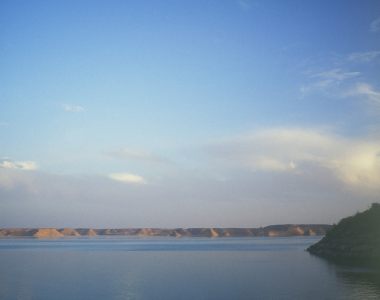 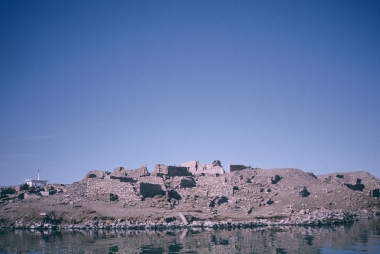 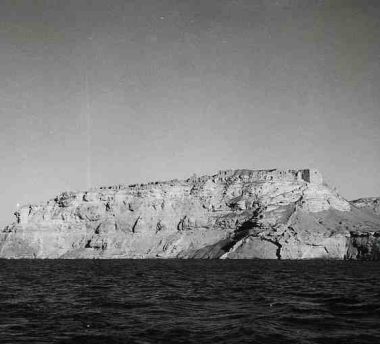 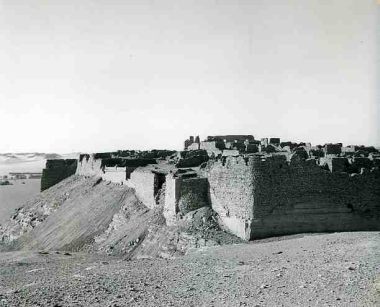 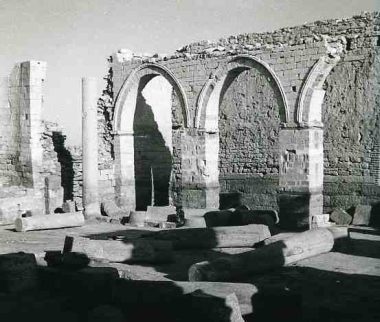 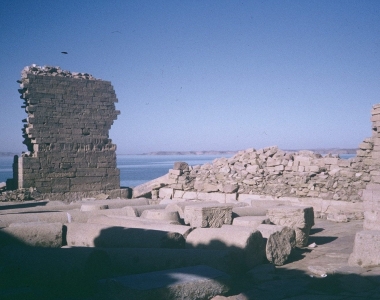 View over the Nubia lake (Nasser lake) in the surroundings of Qasr Ibrim / Vue du lac Nubia (Lac Nasser) de la région de Qasr Ibrim
Qasr Ibrim mountain partly immersed by the Nubia lake after the High
Dam construction near Assouan (Egypt) / Montagne de Qasr Ibrim en
partie immergée après la mise en eau du Haut-Barrage près d'Assouan
(Egypte)
View over the ruins of the Qasr Ibrim citadel before the construction of the High Dam near Assouan, Egypt (Photo R. Keating 1959) / Vue sur les ruines de la citadelle de Qasr Ibrim avant la mise en eau du Haut-Barrage près d'Assouan, Egypte (Photo R. Keating 1959)
The citadel of Qasr Ibrim before the construction of the High Dam near Assouan, Egypt (Photo R. Keating 1959) / La citadelle de Qasr Ibrim avant la construction du Haut-Barrage d'Assouan, Egypte (Photo R. Keating 1959)
Cathedral built inside the citadel of Qasr Ibrim at the christian period (Photo R. Keating 1959) / Cathédrale construite à l'intérieur de la citadelle de Qasr Ibrim à l'époque chrétienne (Photo R. Keating 1959)
Cathedral built inside the citadel of Qasr Ibrim at the christian
period / Cathédrale construite à l'intérieur de
la citadelle de Qasr Ibrim à l'époque chrétienne
|
|
After the death of Cleopatra, the emperor Augustus seizes the crown of Egypt. It seems that the relations between the kingdom of Meroe and the Roman prefect Gallus, are peaceful. However, around 25 BC a Candace (Meroitic queen) attacks Aswan. There is an immediate reaction by the new governor Petronius, who takes Qasr Ibrim and sacks the town of Napata. Returning to the north, he leaves 400 soldiers in the fort with food supplies for two years. A treaty is signed marking the border at Meharraqa, a border that remains in use until the third century of our era.
In 21 BC the kingdom of Meroe builds two temples there, and Qasr Ibrim becomes an important religious centre. Meroitic texts, found on papyrus, wooden tablets and on ostraca (limestone sherds) concern the administration of the temples. Demotic texts confirm the close ties with the sanctuary at Philae.
At the end of the III Century and at the beginning IV Century AD, the kingdom of Meroe disintegrates and the population called 'X-Group' by Reisner appears. These populations, without writing, use ancestral traditions, such as the ritual sacrifice of living beings. For this period, Meroitic texts suggest that the Meroitic language continued to be spoken after the disappearance of the capital.
The emperor Diocletian restores the frontier at Aswan because of important troubles in Lower Nubia between the local populations, the Nobadae (inhabiting the Nile valley) and the Blemmyes (originating from the Eastern Desert). I n the VI Century AD, the Christian world imposes itself through the arrival of Coptic monks from Egypt and the Julian mission sent in AD 543 by the empress Theodora. The ancient temple of Taharqo is transformed into a church. A cathedral, built in the middle of the site, remains the seat of the Nubian bishops until the 14th Century. Its last bishop, Timotheos, is buried there around AD 1374. On may ask why the cult objects and the statues found in a temple from the time of Taharqo were deliberately destroyed. Were they damaged by Christian iconoclasts? If the capital of Lower Nubia is Faras, Qasr Ibrim turns out to have been an important centre directed by a governor. After the arrival of the Ottomans at the end of the XV century, the cathedral is transformed into a mosque while the walls are reinforced, even though the main fort is on the island of Sai; documents have been found in both Arabic and Turkish. In the XVIII century, there were still some fifty soldiers in the fort. The descendants of what had become a hereditary garrison were finally chased away by the Mamluks in 1811, themselves eliminated by Ibrahim Pasha in 1812. The site is then abandoned.
Today, the reservoir of the High Dam has eradicated all remains below the 60m mark, and Qasr Ibrim is no longer the stronghold than it was during Antiquity.
|
|